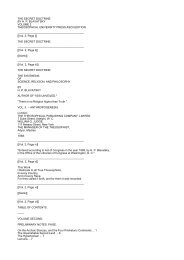Create successful ePaper yourself
Turn your PDF publications into a flip-book with our unique Google optimized e-Paper software.
Plate II.<br />
Sacred Texts Egypt Index Previous Next<br />
PLATE II.<br />
Vignette I.: The disk <strong>of</strong> <strong>the</strong> Sun, supported by a pair <strong>of</strong> arms proceeding from <strong>the</strong> ankh, <strong>the</strong> sign <strong>of</strong> life,<br />
which in turn is supported by a tet <strong>the</strong> emblem <strong>of</strong> <strong>the</strong> East and <strong>of</strong> <strong>the</strong> god Osiris. The tet stands upon <strong>the</strong><br />
horizon. On each side <strong>of</strong> <strong>the</strong> disk are three dog-headed apes, spirits <strong>of</strong> <strong>the</strong> Dawn, <strong>the</strong>ir arms raised in<br />
adoration <strong>of</strong> <strong>the</strong> disk. On <strong>the</strong> right hand side <strong>of</strong> <strong>the</strong> tet is <strong>the</strong> goddess Nephthys and on <strong>the</strong> left is Isis each<br />
goddess raising her hands in adoration <strong>of</strong> <strong>the</strong> tet, and kneeling upon <strong>the</strong> emblem aat, or hemisphere.<br />
Above is <strong>the</strong> sky. This vignette belongs properly to <strong>the</strong> hymn to <strong>the</strong> rising sun.[2]<br />
[1. Maa, unvarying and unalterable Law. Compare <strong>the</strong> vignette from British Museum papyrus No. 9901. (Fig. 1.)<br />
In some papyri <strong>the</strong> apes are four (Naville, Das Aeg. Todtenbuch, Bd. I., B1. 26), or seven (Naville, op. cit., Bd. I., Bl. 21)<br />
in number.<br />
In <strong>the</strong> vignette which usually accompanies <strong>the</strong> hymn to <strong>the</strong> setting sun (Fig. 2), but which does not occur in <strong>the</strong> present<br />
papyrus, a hawk wearing on his head a disk encircled by a serpent, i.e., Ra-Harmachis, {footnote p. 253} takes <strong>the</strong> place <strong>of</strong><br />
<strong>the</strong> disk and (e.g., British Museum papyri Nos. 9901 (Naville, op. cit., Bd. I., Bl. 22,), and 10,472); and <strong>the</strong> tet is<br />
represented by <strong>the</strong> stand ### (Naville, op. cit., Bd. 1., Bl. 22), on one side <strong>of</strong> which are three hawk-headed deities, and on<br />
<strong>the</strong> o<strong>the</strong>r three jackal-headed deities (see Lanzone, Dizionario, 10, pp. 56, 57.). Beneath are Isis and Nephthys kneeling in<br />
adoration before two lion-gods, which represent yesterday and to-morrow. An interesting variant <strong>of</strong> <strong>the</strong> latter vignette<br />
occurs in British Museum papyrus No. 10,472, which was made for <strong>the</strong> lady Anhai, a singer in <strong>the</strong> temple <strong>of</strong> Amen at<br />
Thebes, about B.C. 1000, where, in addition to <strong>the</strong> apes and figures <strong>of</strong> <strong>the</strong> goddesses (<strong>the</strong> titles <strong>of</strong> Isis being ### and those<br />
<strong>of</strong> Nephthys ###, <strong>the</strong>re are represented, on each side (I) <strong>the</strong> winged utchat with pendent uræus and shen ### (emblematic<br />
<strong>of</strong> <strong>the</strong> sun's circuit) and fea<strong>the</strong>r (2) a man, prostrate, adoring <strong>the</strong> disk; (3) four men, upright, with both hands raised in<br />
adoration; and (4) a human-headed bird ###, emblematic <strong>of</strong> <strong>the</strong> soul <strong>of</strong> <strong>the</strong> deceased lady, standing upon a pylon.]<br />
{p. 253}<br />
Text: (1) [HYMN TO OSIRIS.] "Glory be to Osiris Un-nefer, <strong>the</strong> great god within Abydos, king <strong>of</strong><br />
eternity, lord <strong>of</strong> <strong>the</strong> everlasting, who passeth through millions <strong>of</strong> years in his existence. Eldest son <strong>of</strong> <strong>the</strong><br />
womb (2) <strong>of</strong> Nut, engendered by Seb <strong>the</strong> Erpat,[1] lord <strong>of</strong> <strong>the</strong> crowns <strong>of</strong> <strong>the</strong> North and South, lord <strong>of</strong> <strong>the</strong><br />
http://www.sacred-texts.com/egy/ebod/ebod14.htm (1 <strong>of</strong> 3) [8/10/2001 11:24:50 AM]

















